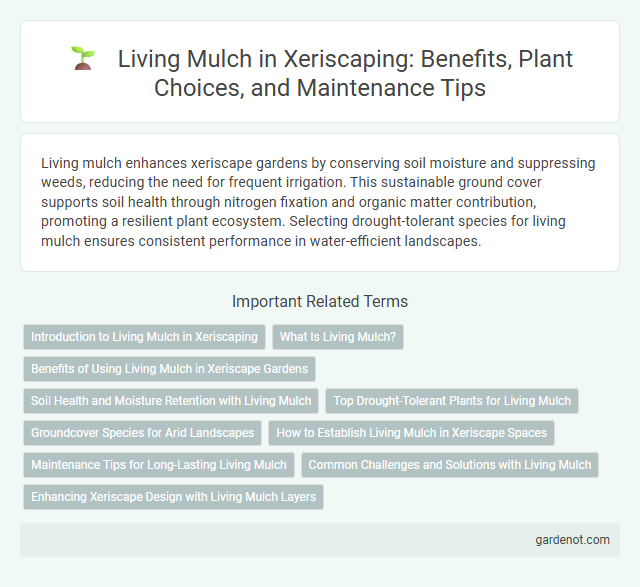Living mulch enhances xeriscape gardens by conserving soil moisture and suppressing weeds, reducing the need for frequent irrigation. This sustainable ground cover supports soil health through nitrogen fixation and organic matter contribution, promoting a resilient plant ecosystem. Selecting drought-tolerant species for living mulch ensures consistent performance in water-efficient landscapes.
Introduction to Living Mulch in Xeriscaping
Living mulch in xeriscaping involves planting low-growing, drought-tolerant ground covers that protect soil moisture and reduce erosion. These plants improve soil health by enhancing organic matter and suppressing weeds without competing heavily for water. Common choices include clover, creeping thyme, and native grasses, which are selected specifically for their water efficiency and resilience in arid landscapes.
What Is Living Mulch?
Living mulch refers to low-growing plants used to cover soil, reducing water evaporation and preventing erosion in xeriscape gardens. These plants compete minimally with main crops for nutrients and water while improving soil health by enhancing organic matter and microbial activity. Common living mulches include clover, creeping thyme, and native ground covers adapted for drought tolerance.
Benefits of Using Living Mulch in Xeriscape Gardens
Living mulch in xeriscape gardens enhances soil moisture retention by reducing evaporation, which conserves water in arid climates. It improves soil fertility through nitrogen fixation when using leguminous plants, promoting sustainable growth without chemical fertilizers. This ground cover also suppresses weed growth and prevents soil erosion, maintaining garden health and reducing maintenance efforts.
Soil Health and Moisture Retention with Living Mulch
Living mulch enhances soil health by promoting microbial activity and improving soil structure, leading to increased organic matter content. Its dense cover reduces evaporation, significantly boosting moisture retention and minimizing irrigation needs. By protecting soil from erosion and suppressing weeds, living mulch supports sustainable xeriscape landscapes in arid environments.
Top Drought-Tolerant Plants for Living Mulch
Top drought-tolerant plants for living mulch include creeping thyme, sedum, and creeping juniper, which thrive in arid conditions while providing ground cover that reduces soil evaporation. These species enhance soil moisture retention and suppress weeds, making them ideal for xeriscape landscapes. Their deep root systems improve soil structure and support sustainable water conservation practices.
Groundcover Species for Arid Landscapes
Living mulch in xeriscaping utilizes drought-tolerant groundcover species such as creeping thyme (Thymus serpyllum), sedum (Sedum spp.), and ice plant (Delosperma spp.) to reduce soil erosion and retain moisture in arid landscapes. These groundcovers enhance soil health by providing organic matter and minimizing evaporation, which supports sustainable water conservation practices. Selecting native or well-adapted species further increases resilience against harsh conditions typical of dry climates.
How to Establish Living Mulch in Xeriscape Spaces
To establish living mulch in xeriscape spaces, select drought-tolerant groundcovers such as creeping thyme, sedum, or buffalo grass that require minimal water and maintenance. Prepare the soil by clearing weeds and loosening the surface to promote root growth, then plant the living mulch in well-spaced rows or clusters to ensure coverage and airflow. Regular monitoring for pests and occasional watering during dry periods help maintain healthy living mulch, enhancing soil moisture retention and reducing erosion in xeriscaped gardens.
Maintenance Tips for Long-Lasting Living Mulch
To ensure long-lasting living mulch in xeriscape gardens, regularly trim the plants to prevent overgrowth and maintain healthy coverage. Apply organic mulch around the base to conserve moisture and suppress weeds, reducing the need for frequent watering. Monitor soil moisture levels and adjust irrigation to avoid overwatering, promoting deep root development and drought resilience.
Common Challenges and Solutions with Living Mulch
Living mulch often faces challenges such as competition for water and nutrients with primary crops, which can reduce overall yield. To address these issues, selecting drought-tolerant species with low nutrient demand and managing mulch density helps optimize resource sharing. Integrated pest management techniques and timely mowing also control pest buildup, ensuring healthier plant growth within xeriscape systems.
Enhancing Xeriscape Design with Living Mulch Layers
Living mulch layers improve xeriscape design by conserving soil moisture and suppressing weeds, reducing water usage significantly. These drought-tolerant ground covers create a natural barrier, maintaining soil temperature and preventing erosion in xeric landscapes. Integrating species like creeping thyme or sedum enhances ecosystem health while promoting sustainable, water-wise gardening practices.
Living mulch Infographic

 gardenot.com
gardenot.com